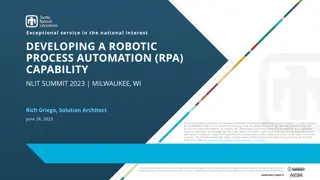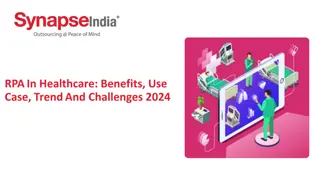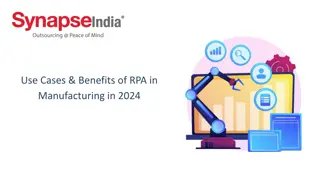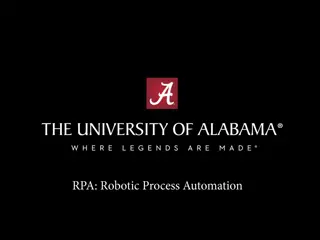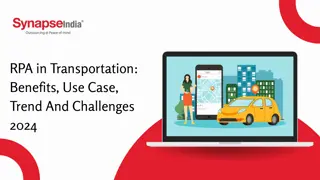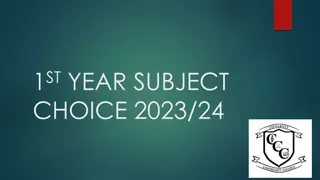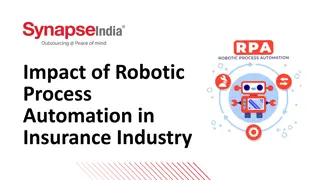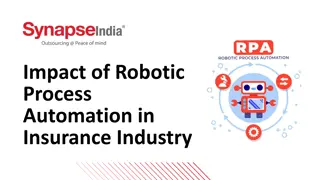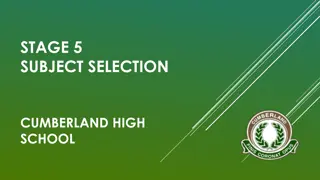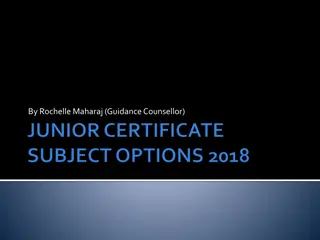Maximizing Student Potential with RPA and B Subjects
RPA and B subjects offer a versatile curriculum for all students, with similar assessments and the ability to cater to different learning styles. Running both subjects in the same class can optimize funding, reduce class sizes, and enhance student success rates. Factors influencing the choice between RPA and B include topic suitability, reflection vs. evaluation skills, and proficiency in extended writing methods.
Download Presentation

Please find below an Image/Link to download the presentation.
The content on the website is provided AS IS for your information and personal use only. It may not be sold, licensed, or shared on other websites without obtaining consent from the author. Download presentation by click this link. If you encounter any issues during the download, it is possible that the publisher has removed the file from their server.
E N D
Presentation Transcript
RPA A subject for every student
Its history means it is often under- utalised. In many schools it is promoted as a subject for lower ability students however it is a fabulous option for all students. Generally, across the state, about 2/3 s of enrolments are in RPB and 1/3 in RPA. Who does this subject?
RPA can be used to increase your ability to differentiate in a class Most classes are a mixture of RPB and RPA. This shouldn t be a problem as the subjects are near to identical in the school assessment. Assessment type 1 Folio is the same, and Assessment type 2 Outcome, only differs in word count allocation (2000 words or 12 minutes for RPB and 1500 or 10 minutes for RPA).
Major Difference is in the Major Difference is in the External Task External Task In RPB this is an Evaluation which must be written (1500 words). In RPA it is a Review to a maximum of 1500 words if written or a maximum of 10 minutes for an oral presentation, or the equivalent in multimodal form (excluding the written summary).
RPA and B can be run in the same class Same teaching for the majority of the semester just different focus for the external. You can guide and decide on final enrolments in each subject as the term progresses. Once students are actually doing the subject they can decide more easily which enrolment will suit them better.
Students may be more likely to pass the first time reducing the need to run classes in the following semester. This gives funding back to the school to reduce class sizes, create more specialist classes and so on. RPA and B students can be all together in the one class which means classes can be more evenly balanced and so reduce cost and load. How can running both subjects aid your school?
What factors impact choice of RPA or B? Topic choice in terms of what would fit better in a 1500 word Outcome than a 2000 word Outcome. Skills in reflecting compared to evaluating they are quite different. Many students have had more experience in reflecting during their schooling, than evaluating, and therefore find it easier to do. Skills in producing extended writing some students are better at voice recording or multi-modal than writing and can get this done quickly with greater ease. You will have plenty of time to work out which students would be better suited to which subject see the key dates to follow.
Hint: Hint: Ensure you have Ensure you have at least one student one student enrolled in enrolled in RPA from the mixed class, RPA from the mixed class, and then you can add and then you can add more students to that more students to that Investigation results Investigation results sheet sheet even after 12 even after 12th th May to change enrolments. to change enrolments. at least May
Hints Hints for for success success in the in the Review Review
WRITTEN SUMMARY: 150 words or 1 minute multi-modal REVIEW: 1500 words or 10 minutes oral/multi-modal Students should play to their strengths and choose an appropriate format Written report Powerpoint / google slides with voice over Discussion: questions and answers Video Oral - - The summary The summary content is exactly content is exactly the same as RPB the same as RPB except it can be except it can be oral/multi oral/multi- -modal. It is assessed. It is assessed. - - modal. -
Hint 1 - In RPA I advise students to cover more of their research processes in the summary as these don t tend to come out in their Review as much. They should make the summary count a good summary will put the marker in the The summary The summary content is exactly content is exactly the same as RPB the same as RPB except it can be except it can be oral/multi oral/multi- -modal. It is assessed. It is assessed. picture and make them want to listen/read on. modal.
Having an interest in both children and the law I was fascinated with the idea of finding out about mothers incarcerated in prison with a child. My Research Question became What are the advantages What are the advantages and disadvantages of an incarcerated woman being able to keep their children (under the age of 3) and disadvantages of an incarcerated woman being able to keep their children (under the age of 3) living with them in jail? . living with them in jail? . After researching what Australian prisons currently allow children to be with their mothers in jail, I explored the age range of such children, finding they are mostly newborn to 3 years old. I focused on where children could be accommodated in jail as well as the health and social impacts on both mother and child of living this way. I also examined alternatives and risks to all involved. Two zoom interviews with professionals, such as Suz Foley Adelaide Women s Prison chaplain, and Professor David Platter, Adelaide University Law criminology expert were conducted along with secondary research.
Hint 2 Hint 2- - Get the headings the headings in the in the Review, Review, exactly right exactly right Get R1: Review of the knowledge and skills developed in response to the research question R2: Discussion of decisions made in response to challenges and/or opportunities R3: Reflection on the quality of the Research Outcome
R1: REVIEW OF THE KNOWLEDGE AND SKILLS DEVELOPED IN RESPONSE TO THE RESEARCH QUESTION. 500 words or 3 mins 30 secs
Hint 3: Put time into preparing students for each Hint 3: Put time into preparing students for each section before they write or record. section before they write or record. Having prompting questions will assist students in reflecting on the knowledge and skills that were developed in the Research Project. Q1. Before you started this topic, did you know much about your topic? What did you know about your topic before you began? Q2. Look at your Folio. What were some of the key things that you learnt during the research process? Write down some of the key things you learnt Write down some of the key things you learnt (consider your reflections). (consider your reflections). Which sources did you find these things out Which sources did you find these things out from (write their name)? from (write their name)? Explain why it was interesting or important for Explain why it was interesting or important for your topic to learn these things. How did it your topic to learn these things. How did it help you answer your question? help you answer your question?
Q3. What were some skills that you developed in the research project? Possible Skills you may have developed Explain how you developed these skills Why were these skills important to learn? How did it help you answer your research question? Q4. What was the most useful way that you collected information? Why was it useful for you? Q5. How will you use the information you learnt in your project, in the future? How could it help you in your future life / study / work? Q6. How will you use the skills you learnt in your project in the future? How could it help you in your future life / study / work?
Hint 4 Hint 4 - - If the student only identifies research skills, I advise them to If the student only identifies research skills, I advise them to devote more of their 500 words/ 3 minutes to discussing the devote more of their 500 words/ 3 minutes to discussing the development of their knowledge, as they tend to be very generic and development of their knowledge, as they tend to be very generic and lacking in specificity when discussing research skills. lacking in specificity when discussing research skills. You can help students discover more appropriate skills by showing them You can help students discover more appropriate skills by showing them skills in the area of their topic. skills in the area of their topic. For example For example http://www.prospects.ac.uk/options_with_your_subject.htm http://www.prospects.ac.uk/options_with_your_subject.htm scroll to the bottom of the page.) Otherwise search the net with terms like skills the bottom of the page.) Otherwise search the net with terms like skills related through nutrition . related through nutrition . Keeping track of such skills as they develop will build their folio as well. Keeping track of such skills as they develop will build their folio as well. scroll to
Before researching the topic of mothers with clinical depression, I had little knowledge of the effects this disease can have on the mother's offspring. However after conducting my first interview with Nurse Unit Manager Sue Ellershaw from Helen Mayo House, my knowledge in this area grew and I formed a wide variety of new ideas. For example I found out that if the mother has severe depression after their infant is born, this may impact on the baby s ability to learn and develop due to lack of nurturing interaction which may cause the baby to shutdown . Another new piece of knowledge that I developed came from the Still Face Experiment. In this experiment a mother faces her baby, and is asked to hold a 'still face', in which she does not react to the baby's behaviours. The reactions of the baby are then observed. This knowledge really changed my thinking about how even a very young baby can be affected by a mother who doesn t display any emotion which is a characteristic of depression. Before I started this research I would have thought that little babies would not be effected as their development would mean that they wouldn t be able to pick up on the emotions of the mother but I now realise that this was very wrong. This helped me understand that clinical depression in mothers is something that needs to be dealt with as soon as possible because it is having long lasting effects on the child even if they are new born. I also gained many skills in how to research. Before my interview with Sue Ellershaw, most of my research was formulated from small articles that did not provide much information on my research topic. However, after working with my teacher to try and fill in holes in my research ,I discovered ways to gain optimal research through utilising google scholar. This was very helpful and I now know how Google scholar can give me very different types of research in comparison to just searching in Google. It was through Google Scholar and the articles I then accessed that I came across many new experts to interview such as Andrea Reupert and FaPMI coordinators Violetta Peterson and Christopher Dutton. I also learnt how to change my search terms if I wasn t happy with the information I was finding and how to search for just Australian information by adding :au to the end of my searches. All of this really improved my skills of research.
R2: DISCUSSION OF DECISIONS MADE IN RESPONSE TO CHALLENGES AND/OR OPPORTUNITIES. 500 words or 3 mins 30 secs
And again...some prep work to assist students in their reflecting... Write down a challenge you faced. Write down some decisions you made to deal with this challenge How did this decision help you? What did it make you learn? Develop? Rate how successful this decision was. Did it help you overcome the challenge? Write down an opportunity that you had. Write down some decisions you made to maximise this opportunity. How did this decision help you? What did it make you learn? Develop? Rate how successful this decision was. Did it help you maximise this opportunity?
Hint 5 Hint 5 - - for success for success in R2 in R2 Make sure that something from all parts of the planning table shown, are mentioned. Keep the challenges/opportunities to a brief overview brief overview emphasise the other two sections of the table much more. to a Challenges doesn t mean gripes . You are acting as a researcher. Discuss both positive and negative impacts on the research due to the decision taken due to the decision taken.
In this graph it is clear I (orange line) was progressing throughout the duration of the time I was following the cardiovascular endurance program, as you can see Jess results (blue line) did not improve, they declined. This makes it visible that the cardiovascular endurance program worked for me. RPA and RPB: you can use graphs / images / etc...
R3: REFLECTION ON THE QUALITY OF THE RESEARCH OUTCOME. 500 words or 3 mins 30 secs
And finally, for R3, students need Pre- work for students to consider: Q1. How well did your Outcome answer your research project question? Please circle: Not at all Somewhat Mostly Very well Q2. How much evidence did you have to support each of your findings? Please circle: Not very much only one or two sources A bit three or four sources A decent amount five or six sources A good amount seven or eight sources A lot over eight sources Way too much Q3. How clear was your introduction? Did the reader get an understanding of your question straight away? Please circle: Not clear at all Somewhat clear Mostly clear Very clear
Q4. How well did you answer each of your key findings? Was this KF answered clearly (yes/no)? Did you have a range/number of sources to support your answer (yes/no)? Did you synthesise the information in your outcome clearly (yes/no)? Key finding 1. 2. Looking at the table, which Key findings were answered most strongly? Highlight these.
Q5. How strong was the communication in your outcome? Tick what you did well: -The structure was very clear -Subheadings help the reader know what they are reading -Topic sentences answer the question -Paragraphs are separated into key ideas -Comparison is made between sources -References show the credibility and reliability of the sources Q6. Was your outcome the best way for you to show what you learned? Q7. How did writing your outcome help you understand your topic more?
R3- Reflection on the quality of the Research Outcome I was extremely happy with the quality of my written Outcome and how it answered my research project question of In what ways can mobile phone apps assist in preventing still births? . Statistical data made my key findings reliable as they clarified the effect of decreased foetal movement and the slow reporting rate by mothers which increases the risk of a stillbirth. I used only quality in-depth information to support my answer and to substantiate everything I said which makes my Outcome credible to the reader. For example, I was able to use World Health Organisation statistics to show that Australia s still-birth rate is too high and then also support this with interviews and research papers from world experts such as Professor Vicky Flenady and Dr Glen Gardner. Since my goal was to convince readers that this is an issue that society needs to address, I think that I achieved my aim. However, I can see that a weakness in my Outcome is the lack of data available linking the foetal tracking app My Baby s Movement, to a decreased numbers of still births. This is due to the newness of the technology and the limited availability of this app at the moment as it is still in its trail phase. While my Outcome had lots of other evidence indicating that this may be so, it lacked direct evidence which weakens my argument overall. Another area of my Outcome that could have been addressed more thoroughly is related to my argument about how Low Socio Economic Status is a contributing factor to a stillbirth due to the lack of assistance these mothers reach out for from the health industry. My research showed that low SES mothers were more than twice as likely to have a Still-birth. I was able to interview Dr Diane Rodgers from Adelaide University who had done research in to how best to communicate with low SES mothers, and her findings were that phone apps were the best way. However this was the only source I had indicating this and I think that lack of substantiation from other sources weakened this point in my Outcome. Overall readers could examine the information provided and understand the subject of stillbirth. I made clear the point that stillbirth is considered to be a taboo topic in society and this fact is affecting the quality of the information that mothers get from health providers. Hopefully my Outcome goes some way towards addressing this important issue.
Hint 6 Hint 6 - - for success in R3 success in R3 Highlight both the successes and limitations of the Outcome and the findings. for Articulate what was hoping to be achieved and then reflect realistically on whether that did in fact occur. Use judgement words like quality, value, worth, significance, importance of, reliability, strengths, limitations. Don t exaggerate. Give equal measure to this component.
Hints for success- overall Chunk the work. Teach then write R1, Teach then write R2 and so on. Set aside a clear number of weeks for doing this make sure students aren t still trying to finish other aspects of the subject. Time passed makes reflection sharper. Use oral Reviews make a power-point that the student can talk to and record the screen using ScreenCast-O- Matic, or Power-point mix or any other form.









